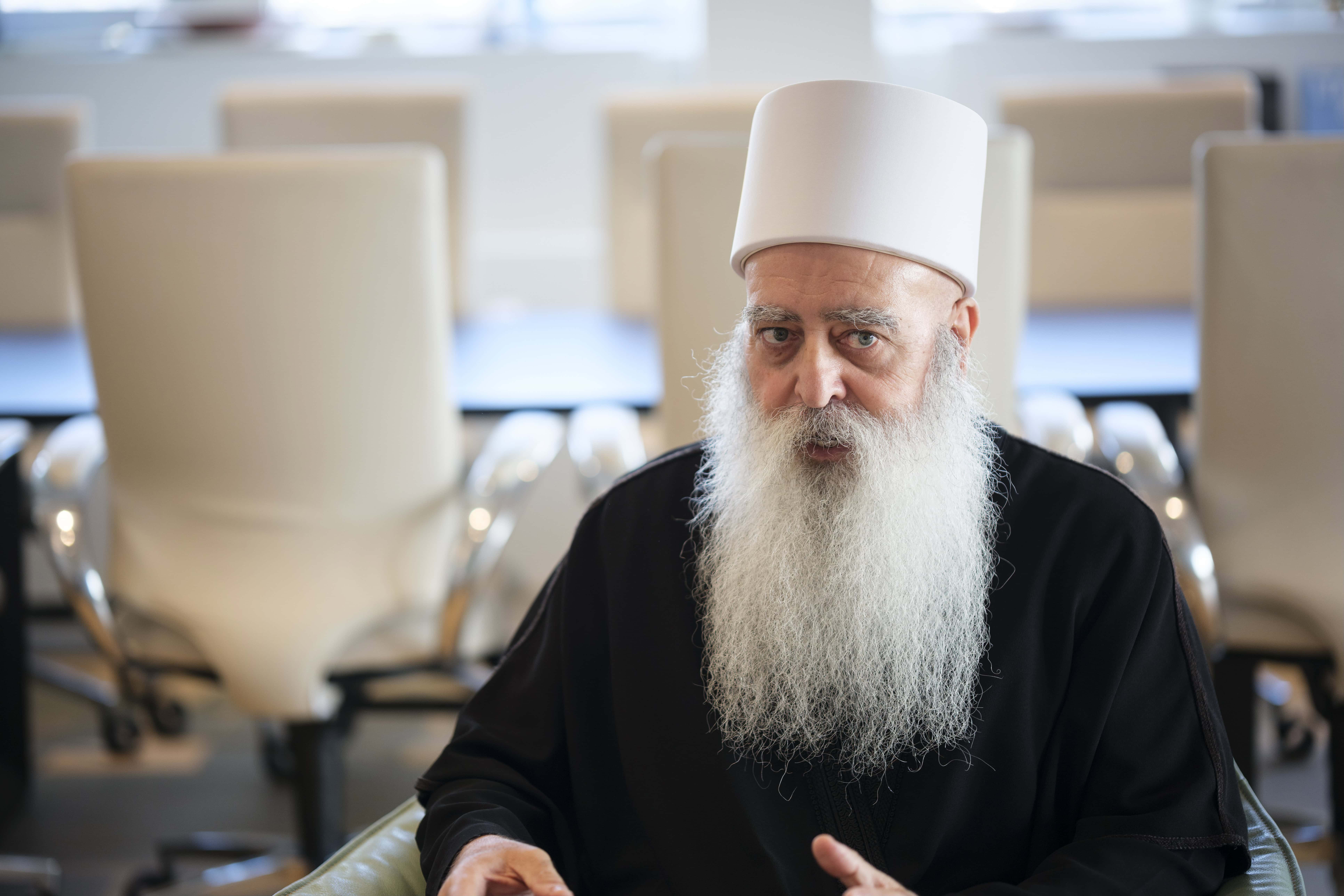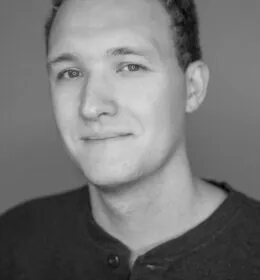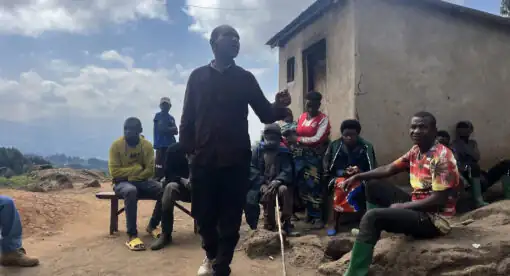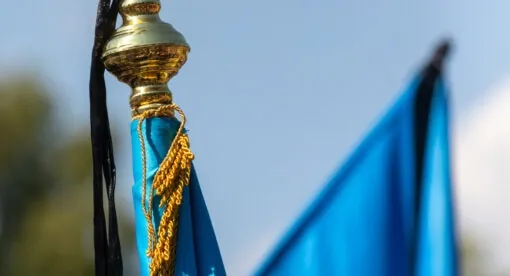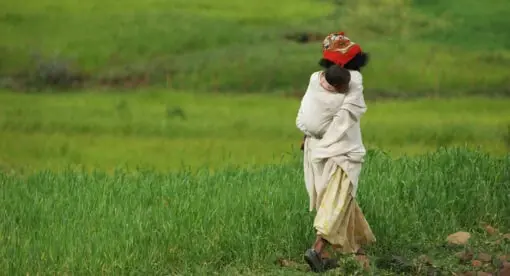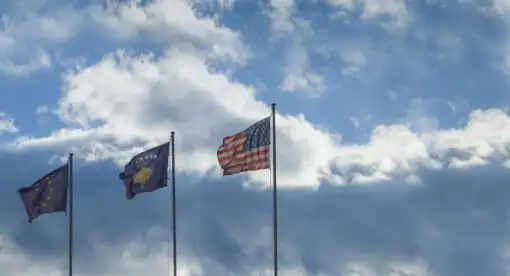Hamas’ assault on Israel on Oct. 7, 2023, led to seismic political shifts in Israel, Lebanon, and Syria, elevating the role of the Druze in regional geopolitics. While communal ties were strong before the attacks, the strained relations among all three states limited Druze integration. Druze communities have historically favored integration within nation-states, lacking the aspiration of an independent state as other minority groups in the region have advocated. Due to their small size, Druze communities learned to prioritize survival within their local contexts over the course of centuries.
Policymakers and analysts should acknowledge that while Druze communities are active in defending Druze in neighboring states, the group comprises a diverse range of positions and rivalries, each informed by their own unique local context. Understanding the Druze requires a nuanced understanding of the local political environment and the pain points between the community and the state. While U.S. policymakers will find ample disagreement with Druze positions on any number of issues, the community has played a central role in shaping the new regional order in a post-Oct. 7 Middle East. Understanding such dynamics will allow policymakers to identify opportunities to engage Druze factions and personalities to work on issues of mutual interest.
Israel
Israeli Druze were brought into the country’s mandatory military conscription in 1956, formalizing ties to the state. While this was controversial among Druze initially, over 80 percent of Druze men holding Israeli citizenship opt to enlist into service today – reportedly the highest rate of enlistment of any eligible group in Israel. High enrollment rates are likely due to the communal sense of pride for military service in the Israel Defense Forces that has developed over time and the notion that military service can enhance career prospects. However, Druze views in Israel are not monolithic and vary dramatically based on geography, as Golani Druze remain divided over their place in Israeli society due to Syria’s control of the Golan Heights until 1967. Under international law, the Golan Heights are considered Syrian territory illegally occupied by Israel; the United States, however, considers the Golan as Israeli territory. While more Golani Druze have accepted Israeli citizenship – especially since the outbreak of war in Syria in 2011 – only 20 percent of Golani Druze today are Israeli citizens.
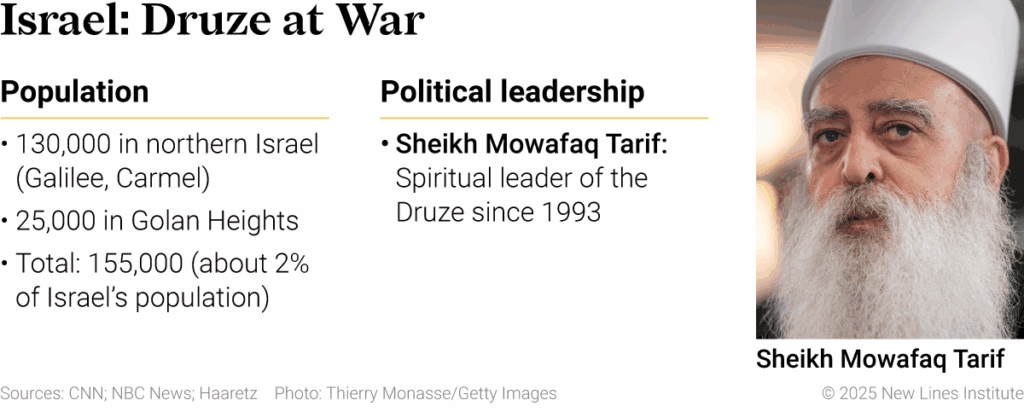
While the Druze largely feel integrated into the state – a 2020 poll from the Jewish People Policy Institute found that 61 percent of Israeli Druze surveyed identified “very much” as “real Israelis” – and continue to serve in the IDF in high numbers, there remain pain points in the relationship. In 2018, the Knesset passed the Nation State Basic Law, which states that “the right to exercise national self-determination in the State of Israel is unique to the Jewish people.” The law was met with protests involving tens of thousands, with Druze leading the demonstrations. The “Kaminitz Law,” which enhanced penalties for building without permits, went into effect in 2017 and has been criticized by Druze ever since. The law provides local executives with expanded powers to demolish buildings and issue eviction notices while bypassing traditional judicial processes. While the law on paper applies to all Israelis, its passage has been viewed by Israeli Arabs as discriminatory due to the government’s low approval rate for building construction in Arab communities, which necessitates the use of unauthorized building practices in the eyes of many Israeli Arabs.
Enhanced Relations After Oct. 7
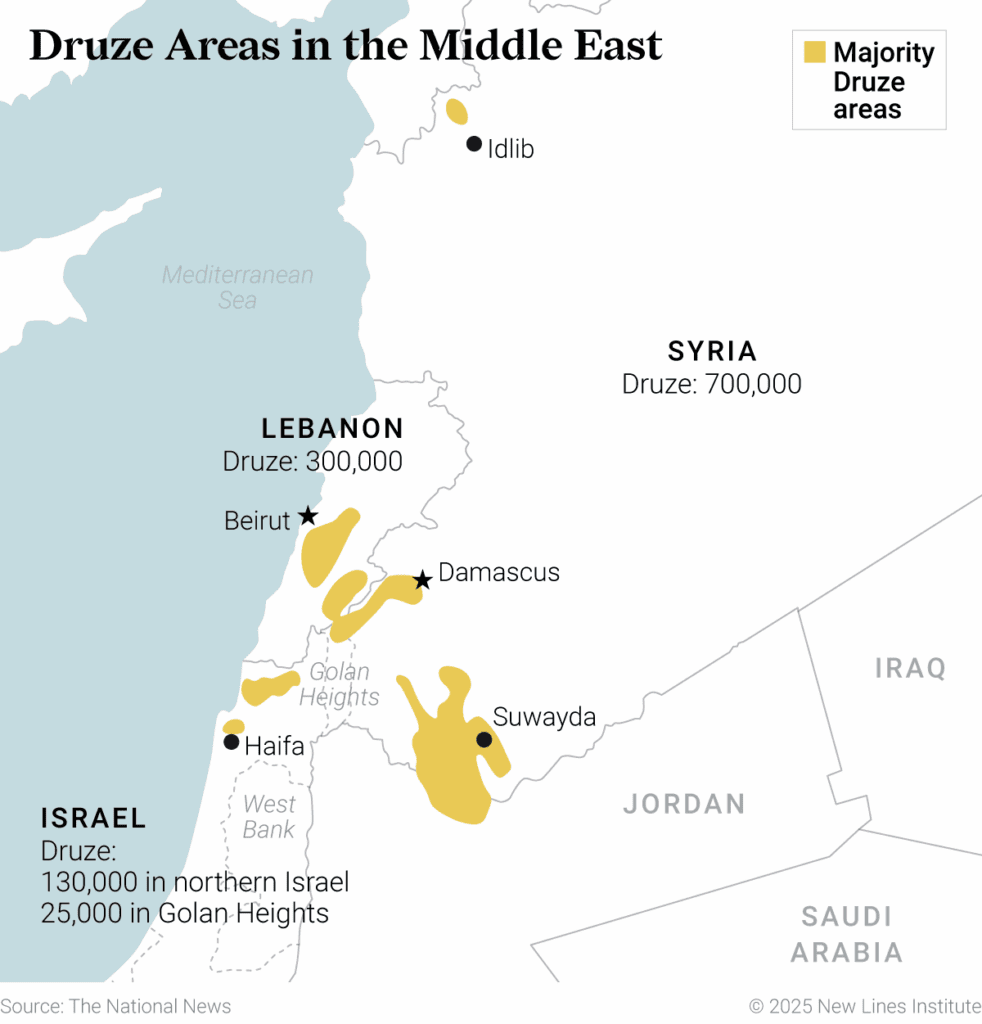
While underlying grievances have increased tensions between Israeli Druze and the state, the Oct. 7 attacks in many ways brought Druze communities closer to the Israeli state. “Several thousand” Druze have operated in Israel’s latest war effort, with at least 13 killed. Immediately after the Hamas attacks, Druze communities started local initiatives to help the war effort. According to a December 2024 poll, 53% of Druze respondents said the war increased their sense of belonging to the Israeli state, with only 7.5% reporting deteriorating ties. Eighty percent of Druze residents feel part of the Israeli state and its problems, per a December 2023 Israel Democracy Institute poll. The feelings of enhanced closeness are likely due to the significant number of Druze soldiers serving – and dying – in the conflict and the acknowledgement that Hamas’ and Hezbollah’s attacks against Israel threaten their communities, too.
Acknowledging the sensitivity of the Druze issue in times of war, the Israeli government announced numerous initiatives to aid the Druze community, including a five-year investment plan, a new elective middle-school curriculum focusing on the Druze and “the historical partnership” between the Druze and Israel, and funding initiatives to “strengthen the socio-economic resilience” of Druze communities.
As Druze combat deaths climbed following the Oct. 7 attacks, there was a revival of discussions to amend or repeal the Nation State Basic Law across the Israeli political scene. Prime Minister Benjamin Netanyahu’s ruling coalition announced its intent to push through a new Basic Law enshrining Druze rights. Members of the National Unity Party – which received the highest percentage of Druze votes in the 2022 elections – proposed an equal rights amendment, but not a full repeal. Ultimately, all efforts to amend or repeal the law have stagnated, in large part due to opposition from far-right elements within the ruling government coalition. If there is no change in the law, Druze discontent against the government may increase, creating the potential for large-scale protests like those seen in 2018.
Increasing Calls to Address Underlying Grievances
An analysis of Druze military funerals since Oct. 7 serves as a window into current Druze sentiment, with many displaying their pride in military service while simultaneously criticizing the government for treating their community as second-class Israelis. At the funeral of Col. Ehsan Daqsa, Druze spiritual leader Sheikh Mowafaq Tarif said, “What else do you want from us, dear country?” The grandfather of Maj. Jamal Abbas was even harsher, stating, “I’m ashamed of all the racist laws in the country.” At a ceremony at the military cemetery in Usfiya – attended by many prominent politicians – an attendee speaking to the Jerusalem Post called for the full repeal of the Kaminitz Law, arguing that “it cannot be that a Druze soldier gets a draft order and also receives an order to demolish his home at the same time.”
Hezbollah’s attack on Majdal Shams in the Golan Heights in July 2024, which killed 12 Druze children, highlighted the significant divisions that still remain between Golani Druze and the Israeli state. In a meeting with Tarif, Netanyahu vowed a strong response to Hezbollah in retaliation. Some residents called for the IDF to assassinate then-Hezbollah leader Hassan Nasrallah; others expressed fear that they would be victims of any retaliation. At the funerals, Reuters reported no Israeli flags being present, likely due local pressure to minimize the political nature of the event. While attempting to attend the funerals, Netanyahu and far-right Finance Minister Bezalel Smotrich were met by protestors accusing them of being criminals.
Another concession to Israeli Druze has been Israel’s attempts to portray itself as a protector of the Syrian Druze. Israel has delivered aid packages and conducted medevac operations to remove injured Druze to Israel amidst episodes of violent clashes with the Syrian government and its allies. Israel has increasingly allowed for religious pilgrimage of Syrian Druze to visit the Nabi Shuaib tomb – seen by Druze as the most important religious site in their faith. Most consequentially, Israel has conducted airstrikes – including against Syrian military targets and on the grounds of government buildings in Damascus as warning shots – in an effort to signal its support for Syrian Druze. By adopting the Druze cause in Syria, Israel is able to tamp down on local Druze anxiety over the fate of fellow Druze in Syria while establishing deterrence against the new government in Syria, which is viewed as a national security threat by many in Israel. So far, Israeli Druze seem to be supportive of their government’s intervention in Syia over the Druze issue. Indeed, per an August 2025 poll by the Israeli Democracy Institute, 44% of Israeli Druze believe that Israel’s level of intervention in Syria on behalf of the Druze is “appropriate,” while 28% do not believe that Israel has gone far enough in protecting their Druze coreligionists next door.
Implications and Future Scenarios
The most likely scenario is that Druze calls for changes to the Nation State and Kaminitz laws will go unaddressed, as ultimately the Druze are a small community lacking access to major power levers within the system. Far-right Israeli government figures have signaled willingness to escalate on issues disproportionately affecting Druze, even as Israel remains on war footing. For example, while pauses have been announced in enforcement of Kaminitz Law in large part due to Druze backlash, Minister of National Security Itamar Ben-Gvir has previously called demolitions “sacred work” and has urged Israeli police to step up demolition activities. Such moves can be a spark that ignites Druze backlash. While Druze service in the IDF will likely continue to be venerated within Israeli society writ large, the rise of far-right Israeli factions – including those in the current governing coalition – will continue to complicate Druze ambitions for expanded civil rights and political representation moving forward.
Lebanon
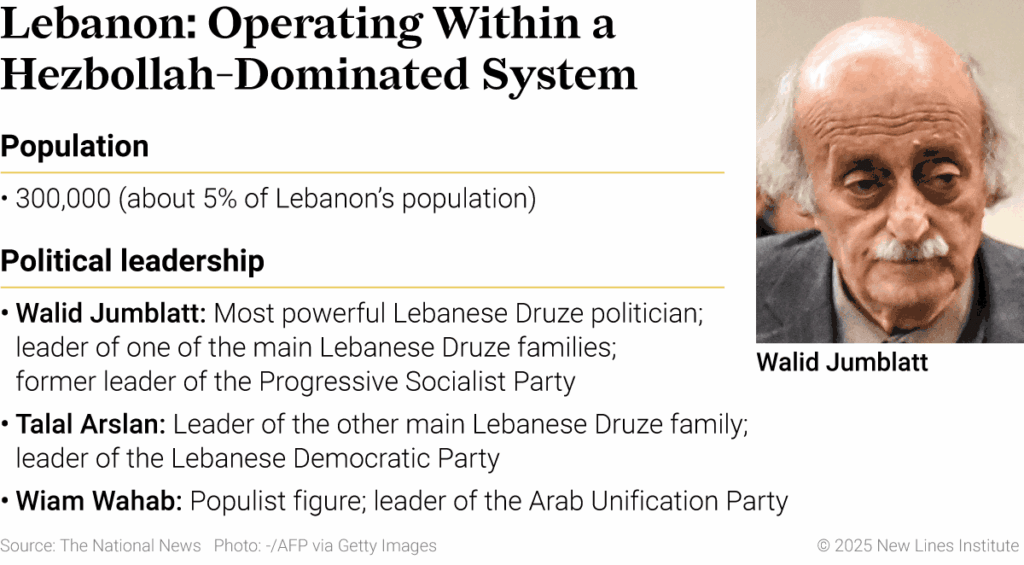
Lebanese Druze leaders offered their support for armed resistance against Israel on Oct. 7. Lebanon’s most prominent Druze politician Walid Jumblatt, the former leader of the Progressive Socialist Party (PSP), characterized the attacks as “a great moment in the history of the Arab-Israeli conflict, and Lebanese Democratic Party (LDP) leader Talal Arslan described Hamas as “brave and heroic resistance fighters.” For Jumblatt, the attack represented an opportunity to reiterate his Arab nationalist views and support for the Palestinian cause. Druze leadership also welcomed Hezbollah’s decision to open a Lebanese front in the conflict. Anticipating Israeli retaliation, Jumblatt called on Druze communities to house the displaced, likely due to his long-held ideological support for resistance against Israel, anchored by the calculation that both Israel and Hezbollah would not escalate to the point of full-scale war, thus making the situation manageable for local Druze constituencies.
Fears that sectarian tensions would grow reverberated throughout the community, intensifying the likelihood for inter-communal violence. For Druze, memories of Lebanon’s 15-year civil war, during which sects were pitted against one another, remain front of mind. Additionally, remembrance of clashes in 2008 between Druze in Jumblatt’s camp and Hezbollah caused many to distrust the group and its grip on Lebanon.
Israel’s Decimation of Hezbollah and Jumblatt’s Turning Point
Hezbollah’s deadly missile strike on Majdal Shams marked a pivotal turning point. Despite Jumblatt’s calling Israel’s claim that Hezbollah was responsible for the attack “lies,” the incident damaged Hezbollah’s position among Lebanese Druze civilians. The Jerusalem Post carried comments from an anonymous Lebanese Druze, who responded to the events in Majdal Shams saying, “Regardless of what Walid Jumblatt says, the Lebanese Druze wholeheartedly hate Hezbollah.” While community leadership backed Hezbollah after Oct. 7, a September 2024 survey from Arab Barometer found that only 9 percent of Druze trust Hezbollah and 16 percent believe Hezbollah’s regional activity is positive. Jumblatt’s response indicates a reluctance at the time to challenge Hezbollah due to its domination of Lebanese politics and their frequent use of armed intimidation and violence against those who push against their agenda in Lebanon. Despite the community’s anger at Hezbollah, Jumblatt’s status as the only viable Druze leader in Lebanon allows him to avoid following public opinion as there remain no major alternative political vehicles for Lebanese Druze to voice their discontent with.
Israel’s targeting of Hezbollah’s top leaders and scores of military commanders and its ground invasion of Lebanon turned Hezbollah into a shell of its former self. The group was ultimately pushed to agree to a ceasefire four months after Israel began its accelerated campaign – all but accepting defeat and beginning a new political reality in Lebanon. Hezbollah’s grip over Lebanese politics – built up over decades – was severely weakened. Jumblatt retreated from his strong rhetoric backing Hezbollah, likely calculating that the future of Lebanese politics – and his place within it – would no longer depend on the group. These changes were evident in several different issue sets:
- Presidential file: Jumblatt backed off his prior support of Sleiman Frangieh – Hezbollah’s preferred candidate – as it became evident that Hezbollah was dramatically weakened and switched his support to President Joseph Aoun, who is backed by Saudi Arabia, Qatar, and the U.S.
- Disarming of Hezbollah: Despite backing Hezbollah’s “resistance” against Israel, Jumblatt more recently called for Hezbollah to be disarmed and “to transform into a political party.” He pushed back on the prospect that Hezbollah can engage in guerilla tactics against Israel, saying, “Hezbollah should understand that now, going back to the old methods … armed resistance – it won’t work.”
- Reconstruction: Jumblatt’s current focus is attracting foreign aid to rebuild southern Lebanon. This is likely due in large part to stresses felt in Druze areas from displaced Lebanese who fled violence and still cannot return home. The issue of what to do with the displaced may require long-term planning on the part of Jumblatt and local Druze governments, as the Gulf states are less likely to invest significant sums of money, as they have in the past, due to competing funding constraints, especially with Syria, Gaza, and domestic reforms being seen as bigger priorities.
- Syria: Soon after the Assad regime fell, Jumblatt met in Damascus with new Syrian President Ahmed al-Sharaa, marking the first meeting between Sharaa and a senior Lebanese politician. Following clashes between Syria’s Druze and pro-government elements, Jumblatt returned to discuss the future of the Syrian Druze. Jumblatt’s embrace of Sharaa and Turkish President Recep Tayyip Erdoğan is likely due to his estimation that he is on the outs with the likes of the Gulf and the U.S. Jumblatt’s increasing ties with Sharaa has the added benefit for him of outflanking Israel in Syria. A political rival of Jumblatt’s – Wiam Wahab, head of the Arab Unification Party (AUP) – claimed he had been coordinating with Tarif, the Israeli Druze leader, to discuss Israeli protection for Syrian Druze, marking a deep division among Lebanese Druze leadership over Syria policy.
Future of Lebanese Druze Leadership
- Jumblatt and the PSP: Jumblatt officially handed off control of the PSP to his son Taymour in May 2023. That said, Walid Jumblatt continues to manage high-level engagements and speak on behalf of the party. Walid is unlikely to voluntarily retire or step down. Interviews with Lebanese Druze highlight that Taymour and many young PSP leaders, lacking the ideological Arab nationalist commitments of the older generation, are more open to ties with Israel.
- Arslan and the LDP: Hailing from the other major Druze family in Lebanon, Arslan has been a staunch supporter of Syria’s Assad regime and Hezbollah. While considered rivals, the two major families have worked to present a degree of Druze unity as a signal that the community is strong and not distracted by internal squabbles. Recently, it seems as if Jumblatt is engaging with Arslan more frequently, potentially as a way to counter Wahab’s populist rhetoric.
- Wahab and the AUP: While not hailing from a major Druze family, Wahab gained influence by presenting himself as a populist provocateur. A staunch supporter of the Assad regime, Wahab frequently criticizes the Sunni Islamist nature of Syria’s new leaders, arguing that the Druze of Syria are under threat. Wahab’s stated support for a “deal with the devil” to normalize ties with Israel is an area to watch, as many Druze citizens likely back such initiative if it will mean the end of Israel military operations in Lebanon.
Implications and Future Scenarios
In the new Lebanon, Jumblatt has backed off his support for Hezbollah and for now is advocating for its disarmament. A revival of Hezbollah or the outbreak of sectarian clashes in Lebanon could reverse this situation. Renewed conflict in Lebanon with Israel or the emergence of civil war in Syria and its spillover effects in Lebanon could also upset the new Lebanese order, potentially causing Druze positions to shift. Additionally, the potential for Hezbollah and its allies to fight back against efforts to disarm the group can act as a spoiler that sparks additional violence in the country. Such a scenario could bring in Druze armed elements, especially if Hezbollah views them as proponents of disarmament efforts.
Syria
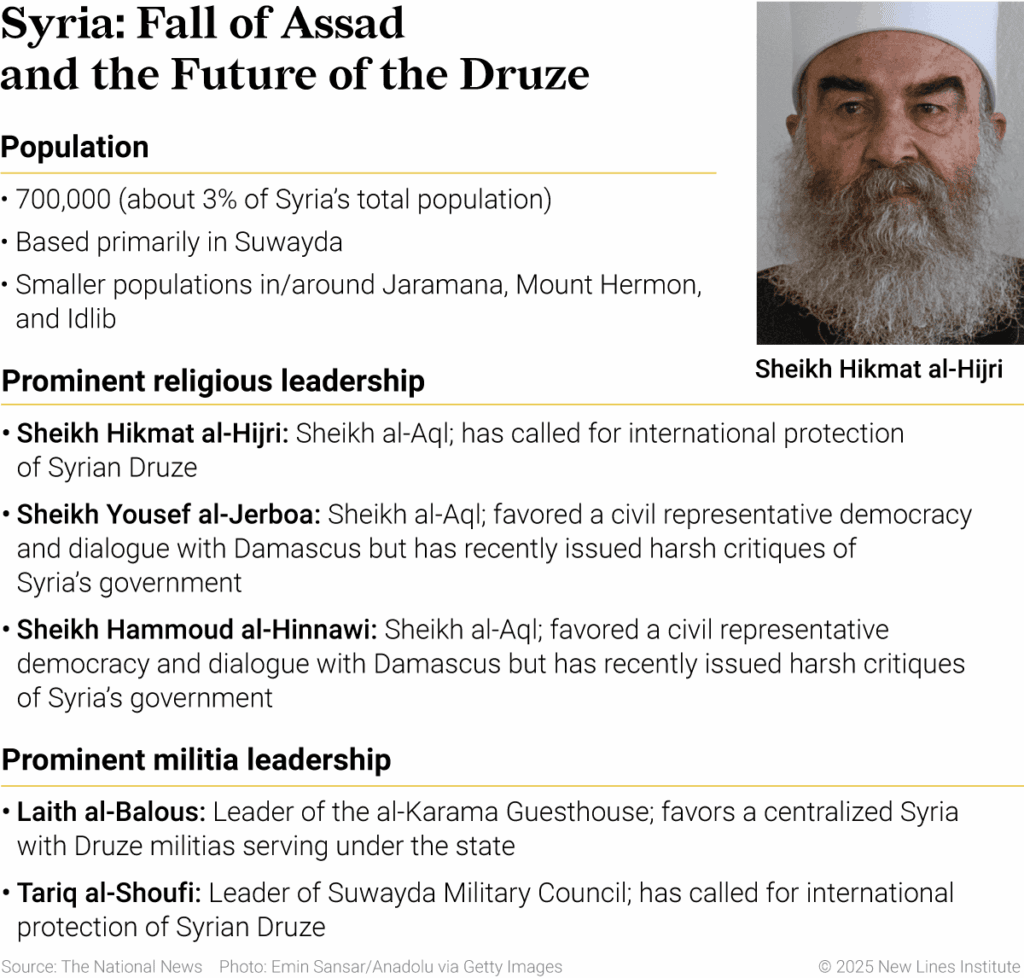
When Sharaa took power in Damascus in December 2024, Druze leadership initially took a wait-and-see approach. Religious leader Sheikh Hikmat al-Hijri called for a “comprehensive national conference” involving Syrians of “all backgrounds and colors.” Many Druze remained skeptical of Sharaa’s government, as memories of Druze massacred in Qalb Lowzeh by Sharaa’s group in 2015 and by the Islamic State in Suwayda in 2018 loom large. Fears that Syria’s new leaders view Druze as apostates worthy of slaughter rose throughout the community.
When the National Dialogue was held in February 2025, Hijri and other senior Druze leaders were excluded in favor of lower-level community representatives. Prominent armed factions in Suwayda boycotted the event due to lack of representation. The event ended up doing little to reassure Syrian Druze that Sharaa could be trusted.
Acknowledging these grievances and aiming to integrate Druze elements within the state system, Sharaa has attempted to win the community’s trust by courting select Druze figures, with mixed success. Sharaa engaged in high-level meetings with prominent Druze leader Laith al-Balous, leader of the al-Karama Guesthouse and hailing from a prominent Druze family. Balous, who sees himself as a Syrian Arab nationalist, has rejected Druze secession and Israeli interference, preferring to work with the government in Damascus. Balous has served as a key liaison for the Presidential Palace in pushing for Druze integration into the state security organs.
The mashyakhat al-aql – the preeminent Druze spiritual body in Syria initially hedged due to skepticism of the new authorities. Sheikhs Hinnawi and Jerboa had been willing to engage with Damascus and expressed a preference for a centralized Syria, Hijri has pushed increasingly against the government, advocating for external assistance to the Druze and a decentralized approach.
Geographic and demographic considerations also play a role. Since Suwayda is 90% Druze and is isolated in the south, local leadership can afford to play hardball with the new government; Druze in more mixed areas like Jaramana, have been more likely to reach accommodations quickly due to intensified fears of inter-communal violence.
Skepticism of Damascus Rises
However, tensions between Syria’s Druze and the new regime escalated in March 2025 when government-affiliated forces killed hundreds along the Syrian coast, largely fellow minorities from the Alawite community. The massacre eroded the already fragile trust built up between the new government and minority communities, including the Druze. The situation further deteriorated in late April in the Druze areas of Jaramana, Ashrafiyat Sahnaya, and Suwayda. Sparked by the sharing of a video via WhatsApp allegedly showing a Druze cleric insulting the Prophet Mohammed, clashes resulted in dozens killed. In response, Hijri released a statement declaring, “We no longer trust an organization that claims to be a government” and described Sharaa’s government as “extremist in every sense of the word” and the violence against Druze as an “act of extermination.” The attacks on Druze emboldened Hijri to call for external intervention – alluding to Israel’s stated aspirations to protect the Druze – putting him at odds with armed leaders like Balous.
Druze anxiety toward the new government in Damascus hardened in July 2025 when major clashes broke out across Suwayda. Tit-for-tat kidnappings between Bedouin and Druze soon spiraled out of control, leading to the Ministry of Defense to deploy to restore order, ostensibly siding with Bedouin factions. The violence – in which more than 800 died, 900 were injured, and 192,000 people were displaced – brought in Druze militias, armed Bedouin factions, Syrian government troops, tribal forces from across Syria, and Israeli airstrikes. The clashes were highly sectarian in nature. Druze men had their mustaches – a symbol of deep cultural pride – forcibly shaved off and were demanded to crawl on their hands and knees in humiliation; some Druze armed factions were accused of indiscriminate slaughter of Bedouin and were photographed celebrating the killings. For many Druze, the deployment of Ministry of Defense personnel to Suwayda represented the crossing of a major red line.
The sectarian nature of the violence and involvement of Syrian government personnel have hardened intra-Druze fissures, adding another obstacle to Sharaa’s efforts to integrate Suwayda into a unified Syria. While difficult to fully assess public opinion, a number of indicators highlight a push on the ground away from integration with Damascus. The Rijal al-Karama faction, for example, had been open to engaging with Damascus in talks since December but took part in the defense of Suwayda against government personnel, seeing their entrance as a red line. Sheikhs Hinnawi and Jerboa – who were engaging with the authorities in Damascus before and favored a centralized Syria – issued statements calling out the government and implying a deep sense of gratitude to Israel for its operations during the episode.
Balous, the strongest Druze advocate for integration, fled Suwayda. In a sign of Balous’ weakened position, Rijal al-Karama – the Druze armed faction started by Balous’s father and of which he was a member until 2016 – released a statement distancing itself from Balous. This was likely done in part due to frequent media characterizations of Balous as the current head of Rijal al-Karama, an image the group is clearly seeking to avoid as it lost nearly 50 fighters in clashes with government and Bedouin personnel.
Israel Presents Itself as Protector
Violence against minorities in Syria created an opening for Israel to present itself as the Druze’s protector. In March, Israeli Minister of Defense Israel Katz said, “We will not allow the extreme Islamic regime in Syria to harm the Druze.” The IDF launched airstrikes on pro-regime targets throughout multiple episodes of violence against the Druze, including against Syrian troops in Suwayda and on the grounds of the Ministry of Defense and Presidential Palace in Damascus, ostensibly to deter further violence against the Druze and to deliver a warning to Syria’s new rulers in Damascus.
Armed factions have fiercely called on Israel to protect Syrian Druze. Advocating for U.S and Israeli intervention to protect Syrian Druze, the Suwayda Military Council (SMC) – aligned with Hijri – was formed shortly following the downfall of the regime by Tariq al-Shoufi, a former military officer who defected from Assad’s forces in 2015. Shoufi’s position represents the growing view that while Israel may have its own agenda in Syria, the Druze would be open to external assistance if the survival of the community is at stake. Shoufi and his group view Sharaa’s government as being of “one color” by excluding large portions of Syrian society and are highly critical of its Islamist origins. If violent clashes continue, Israel will likely increase its involvement in Syria, assessing that local Druze will be more open to accepting their protection if they lack alternatives. Conversely, increasing Israeli engagement in Syria risks casting Druze voices expressing reluctance toward integration with Damascus as an Israeli fifth column, which may push those Druze into self-censoring due to fear of being targeted.
Additionally, protests throughout Suwayda following July’s clashes have featured prominent displays calling for international protection of the Druze, while some have even featured Israeli flags. The formation of the so-called Supreme Legal Committee – backed by Hijri – was another example of steps being taken by actors on the ground to push against Damascus and advocate for paths to self-rule in the governorate.
Implications and Future Scenarios
Episodes of sectarian violence against minorities has severely weakened the Syrian government’s case for centralizing control of Druze areas and armed factions. Israel’s attempts to exploit a vacuum and cast itself as a protector of minorities have also complicated the Syrian government’s case, as Druze may feel more inclined to engage with Israel if sectarian violence continues unchecked. This is evident as calls for international intervention in Suwayda have grown on the ground, including through some prominent displays of Israeli flags at civil society demonstrations.
Whether Druze ties with the Syrian government can recover remains uncertain, especially if there are further incidents of sectarian violence. The prospects for Druze integration into a unified Syria is at its lowest point since Sharaa took over in December 2024. There remains significant dissatisfaction among former Druze regime security personnel and government employees, who have seen their livelihoods diminish since Assad’s fall. If the government cannot increase the economic prospects for these individuals, they may push back against the government, raising opportunities for instability. Violent episodes in Suwayda risk spillover effects into Jordan, which the U.S. should actively try to avoid. Policymakers should pay close attention to potential spoilers in Druze areas, including ongoing tensions and ceasefire violations between Druze and Bedouin forces, which risk increased displacement and instability.
Regional Ties
While Druze decision making is determined mostly by local political factors, the Druze have a shared commitment to their coreligionists in neighboring countries. This is especially visible since Oct. 7 in the public rivalry between Jumblatt and Tarif, both of whom see themselves as the leader of regional Druze and offer competing visions for the Middle East and the role of the Druze in it. Jumblatt advocates an Arab nationalist vision for regional Druze in line with support for the Palestinian cause. Tarif has advocated an Israeli-centered vision for regional Druze, whereby Israeli Druze remain loyal to the state and with Israel serving as a security guarantor for regional Druze under threat.
Jumblatt has argued that Tarif “does not represent” the Druze, citing his support of Israel. Tarif has chided Jumblatt to get Lebanon’s house in order before commenting on other topics. Their rivalry has played out most prominently thus far over the future of Syria, with Jumblatt embracing Sharaa and his vision for Druze to be absorbed within the state structure and Tarif pushing Israel to increase its activities in Syria to protect Druze interests. Tarif’s stature regionally has grown since Oct. 7 – he ignited a firestorm in Lebanon when a photograph of him shaking hands with Aoun was posted online. Highly controversial in Lebanon due to strained ties, Aoun claimed he did not know Tarif and that Israel had purposefully distributed the photo “for suspicious purposes.” Wahab, a rival of Jumblatt’s in Lebanon, has struck up an alliance with Tarif over Syria issues, countering Jumblatt. Jumblatt has been angered by this trend and will likely increase his regional engagement in part to reassert his long-held belief that he alone is the leader of regional Druze.
Policy Recommendations
The changes in the Israeli, Lebanese, and Syrian landscapes since Oct. 7 deserve increased attention from policymakers. Druze communities – despite their small size – have shown the outsized impact they play in both local and regional affairs. Washington should consider the following:
- In Israel, the U.S. should engage in conversations with political and military counterparts regarding efforts to amend the Nation State and Kaminitz laws, both of which are widely seen by Druze as discriminatory. The U.S. should emphasize that the continued approach risks decreasing Druze enthusiasm for military service in the future.
- In Lebanon, the U.S. should re-evaluate its current stance toward Jumblatt, taking advantage of the current moment where he is also advocating the disarmament of Hezbollah and enforcing UNSCR 1701. Working with Gulf allies, the U.S. should engage Jumblatt regarding bringing more reconstruction aid to rebuild Lebanon and get the displaced back to their homes. A July 2025 meeting between U.S. Special Envoy Tom Barrack and Jumblatt was a good first step in this direction.
- In Syria, the U.S. should continue pressuring Sharaa’s government to respect minority rights, including through government representation and preventing sectarian violence. The U.S. should also engage its Israeli partners and discourage support of Druze separation, arguing that such an approach threatens the future of Syrian stability and security while inflaming already deep divisions on the ground.
The views expressed in this article are those of the author and not an official policy or position of New Lines Institute.

